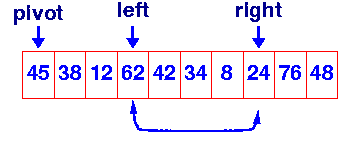| Algorithms |
| Quick
Sort: Partition in place |
Most implementations of quick sort make use of the fact that you
can partition in place by keeping two pointers: one moving in from
the left and a second moving in from the right. They are moved
towards the centre until the left pointer finds an element greater
than the pivot and the right one finds an element less than the
pivot. These two elements are then swapped. The pointers are then
moved inward again until they "cross over". The pivot is then
swapped into the slot to which the right pointer points and the
partition is complete.
int partition( int a[], int low, int high )
{
int left, right;
int pivot_item;
pivot_item = a[low];
pivot = left = low;
right = high;
while ( left < right ) {
/* Move left while item < pivot */
while( a[left] <= pivot_item ) left++;
/* Move right while item > pivot */
while( a[right] > pivot_item ) right--;
if ( left < right ) SWAP(a,left,right);
}
/* right is final position for the pivot */
a[low] = a[right];
a[right] = pivot_item;
return right;
}
|
 |
Note that this above code does not check that left
exceeds the array bound. You need to add this check, before
performing the swaps - both the one in the loop and the final
one outside the loop.
partition ensures
that all items less than the pivot precede it and returns the
position of the pivot. This meets our condition for dividing the
problem: all the items in the lower half are known to be less than
the pivot and all items in the upper half are known to be greater
than it.
Analysis
The partition routine examines every item in the array at most once,
so it is clearly O(n).
Usually, the partition routine will divide the problem into two
roughly equal sized partitions. We know that we can divide n
items in half log2n times. This makes
quicksort a O(nlogn) algorithm.
However, we have made an unjustified assumption - see if you can
identify it before you continue.
Key terms
|
- Divide
and Conquer Algorithms
- Algorithms that solve (conquer) problems by dividing
them into smaller sub-problems until the problem is so
small that it is trivially solved.
|
